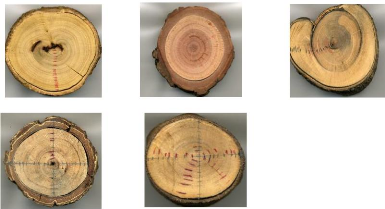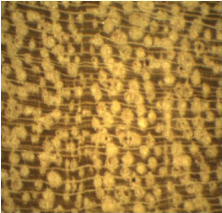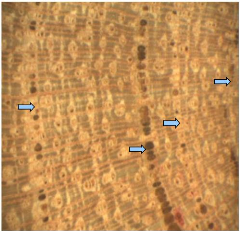4. RESULTS
4.1 Wood anatomy of the species
All dendrochronological investigations of the study were based
on the hypothesis that wood structure varies considerably following the
species. The Figure 2 shows the difference between the species in wood colour,
the aspect of the bark and the distinctiveness of the rings boundaries
depending of the cross-wood sections which were used for analyses.
Specifically, the figure 3 and 4 were chosen for the description of the common
legend of the wood anatomically.

a b c
d e
Figure 2: Macroscopically polished stem discs
observation of investigated species. Fig a. - Fig
b. D. microcarpum (Caesalpiniaceae) - Fig c. D.
abyssinica (Ebenaceae) - Fig d. I. doka (Caesalpinaceae) - Fig e.
P. erinaceus (Fabaceae).
|
Inner bark
Pith
Outer bark Outermost ring
|
|
Heartwood Sapwood
Cambium
Innermost ring
|
Figure 3: The different parts of wood. Stem
disc of D. microcarpum
|
Ring boundaries
(marginal parenchyma band)
|
|
|
Vessels
Radius
Parenchyma
|
|
|
|
Figure 4: The common wood anatomical
4.1.1. Anogeissus leiocarpa
The bark of A. leiocarpa is slightly furrowed with
dirty white drawing sometimes ashy in colour. The sapwood is yellowish and the
difference bet ween heartwood is not so remarkable in young tree.

Figure 5: Wood anatomy of A. leiocarpa
(Combretaceae)
From pith to cambium, we observed the thin radiu ses which are
very near one another. The growth type zone shows variations in the vessel
distributio n (Figure 5). The border of ring is presented like single circular
line. For the samples of UAC (Benin), it was not always easy to identify
macroscopically the rings boundaries when they are narrows. But, all the CNP
samples showed distinct tree-rings by visual observation. Only in stem discs
from CNP, an alternating of early wood and latewood was identified. The
latewood s are very hard and darker. The distinctiveness of ring boundary in
A. leiocarpa trees depends also on the ring size and the environmental
conditions. A. leiocarpa, samples collected from two different sites
showed variation in ring visibility. The samples from CNP have best distinct
rings that may be explained by month rainfall diagram. In this area, the dry
season occurs from November to February like in Benin site (UAC) but it is more
marked. Thus, A. leiocarpa has high tree-ring sensitivity. It is
strongly influenced by changes in moisture conditions. A. leiocarpa
trees react strongly to environmental factors.
4.1.2. Detarium microcarpum
The outer bark was moderated furrowed and greyish with reddish
inner bark. The wood of D. microcarpum is hard and dark brown in
colour. The sapwood was lighter than heartwood. The polished stem disc showed
good distinct tree-rings (Figure 6).

Figure 6: Wood anatomy of D. microcarpum
(Caesalpiniaceae)
There are many parallel rays mostly in sapwood which are
perpendicular to tree rings. In these rays, we identified radial parenchyma
cell s. The small vessels are distributed in all sapwood. No vessel has been
noticed in heartwood. The pith is characterized by spongy tissue. Tree-rings
are darker in colour and were formed by consecutive vessels in single line for
heartwood. The vessels of rings boundaries are bigger. Two successive vessels
are separated by one radius. The radiuses are wide and the growth border was
characterized by marginal parenchyma bands. In sapwood, we did observe that the
growth ring boundary was delimited by single concentric line. The number of
vessels in growth ring border decreases from heartwood to sapwood. Sometimes,
no vessel was noticed in concentric line.
| 


